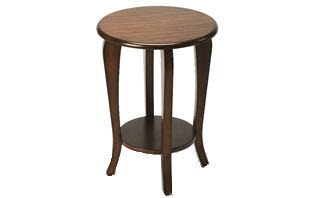How To Price Your Woodworking Projects

Everybody agrees that masterful woodcraft comes at a price, what that price should be is the subject of a lot of debate. Have you ever wondered what to charge for something you made? Virtually every handmade product has a “right price.” Charge more and it won’t sell; charge less and you’re losing money.
Finding the right price requires five separate calculations to determine costs for materials, labor, overhead, profit and selling expenses. You can calculate these by hand, or use your computer and a spreadsheet. Here’s how we would price the pictured accent table.
MaterialsThe materials consist of the actual parts used to make the product and the cost of the wood. The table has 12 board feet of oak, at $3.25 a board foot, so the material comes in at about $39.00.
Labor
Labor is calculated by the hour. Suppose you want to make $75,000 a year. If you take four weeks of vacation a year and work 40 hours a week, then you will work 1,920 hours a year. Divide 75,000 by 1,920, and you get $39.00 an hour. The table took 2.5 hours to make, so multiply $39.00 by 2.5. The labor cost for the table is $97.50. Add this to the materials cost ($39.00) for a total of $136.50.
Overhead Costs
Overhead costs consists of the rental and utilities of your shop, tools, glue, nails, sandpaper and finishing materials. An industry average is 15%. Multiply your total of materials and labor by 15%. For the table, multiply $136.50 by 0.15. ($20.50) and add this amount to $136.50. The total cost for materials, labor, and overhead for the table is now $157.00.
Profit
Profit is the amount added to cover business expansion. Add 10% of $157.00 ($15.70, but round up to $16.00), and you have a final price for the table of $173.00. This is the value of the finished table sitting on your workbench or the “workbench price”. If someone comes to your shop and picks up the table, you could charge them $173.00, because you haven’t incurred any selling costs. At your workbench price, all of your shop costs are covered. However, if they bought the same table in a store, it would cost them $400.00 because of selling expenses.
Selling Expenses
Selling expenses consist of two calculations. The first, the cost to put the table in a store, amounts to 15% of the workbench price. This could be used to pay a sales rep, have a booth in a trade show or to advertise the table in a magazine or newspaper. Add 15% of $173.00 ($26.00) to $173.00, and you get the wholesale price of the table: $199.00.
Retail Markup
A store or gallery will mark up your wholesale price to cover their expenses. This is called the retail markup, usually 100%. To calculate the (suggested) retail price for the table, simply double your wholesale cost of $199.00 and you have a final price for the table, displayed in a store or gallery, of $398.00.

If you create a spreadsheet with your computer, you can calculate the price of many products quickly. You will only have to enter the number of hours to make a product, the salary you want to make in a year, and the cost of materials. The spreadsheet will calculate the workbench price, wholesale price and retail price instantly. Once you know the right price for your work, stick with it. Don’t settle for less.
Keep the inspiration coming!
Subscribe to our newsletter for more woodworking tips and tricks